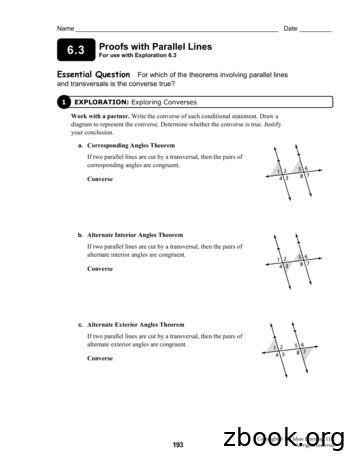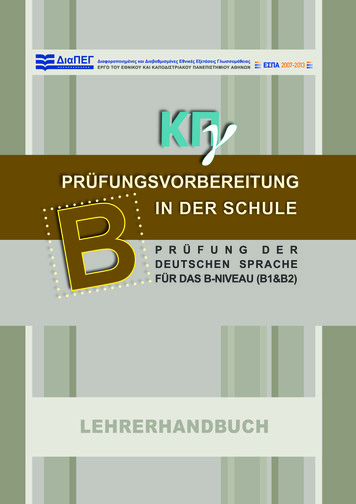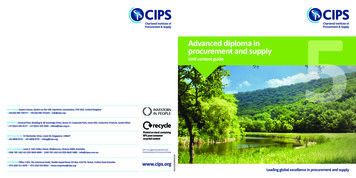AC 20-03 V1.0 - Identification And Management Of .
ADVISORY CIRCULARAC 20-03Identification and management ofaeronautical productsv1.0 – March 2016
IDENTIFICATION AND MANAGEMENT OF AERONAUTICAL PRODUCTSAdvisory Circulars are intended to provide advice and guidance to illustrate a means, but not necessarily the onlymeans, of complying with the Regulations, or to explain certain regulatory requirements by providing informative,interpretative and explanatory material.Advisory Circulars should always be read in conjunction with the relevant regulations.AudienceThis Advisory Circular (AC) applies to: Subpart 21.G - Production Certificate holdersSubpart 21.O - Australian Technical Standard Order Authorisation holdersSubpart 21.K - Australian Parts Manufacturer Approval holdersPart 42 - Continuous Airworthiness Management OrganisationsPart 145 - Aircraft Maintenance OrganisationsPart 30 of Civil Aviation Regulations 1988 (CAR) - Certificates of Approval holders formaintenance or distributionoperators and maintainers of aircraft.PurposeThe purpose of this AC is to provide guidance to the aviation community for identification of aircraftand aeronautical products.For further informationFor further information on this AC, contact Civil Aviation Safety Authority's (CASA’s) Airworthinessand Engineering Standards Branch (telephone 131 757).StatusThis version of the AC is approved by the Executive Manager, Standards Division.Version1.0DateMarch 2016DetailsInitial version. Aeronautical product information published within Civil AviationAdvisory Publication (CAAP) 51-2, CAAP 42W-1 and other relatedairworthiness ACs were reviewed and updated for inclusion within this AC.Whilst previously drafted under AC 21.Q, CASA has determined that thecontents apply to a wider set of regulations than under Subpart 21.Q and thusthe generic 20 series numbering has now been utilised.Unless specified otherwise, all subregulations, regulations, divisions, subparts and partsreferenced in this AC are references to the Civil Aviation Safety Regulations 1998 (CASR).AC 20-03 v1.0March 2016Page 1
IDENTIFICATION AND MANAGEMENT OF AERONAUTICAL PRODUCTSContents1234Reference Background82.1Aeronautical product and aircraft component82.2Approved design92.3Identification of parts102.4Approved parts and unapproved parts132.5Unserviceable parts142.6Unsalvageable parts15Detection of unapproved parts173.2Part records173.3Procurement process173.4Acceptance procedures183.5Supplier evaluations19Reports204.1Unapproved parts204.2Reporting major defects204.3Reporting to CASA204.4Reporting to other approval holders215Salvaging parts226Disposal of parts23AC 20-03 v1.0March 2016Page 2
IDENTIFICATION AND MANAGEMENT OF AERONAUTICAL PRODUCTS1Reference material1.1AcronymsThe acronyms and abbreviations used in this AC are listed in the table below.AcronymDescriptionACAdvisory CircularADAirworthiness DirectiveAMOAircraft Maintenance OrganisationAPMAAustralian Parts Manufacturer ApprovalARCAuthorised Release CertificateATSOAustralian Technical Standard OrderAWBAirworthiness BulletinCAAPCivil Aviation Advisory PublicationCAOCivil Aviation OrderCARCivil Aviation Regulations 1988CASACivil Aviation Safety AuthorityCASRCivil Aviation Safety Regulations 1998COTSCommercial Off The ShelfETSOEuropean Technical Standard OrderFAAFederal Aviation Administration (of the United States of America)FITCOMFabrication In The Course Of MaintenanceICAOInternational Civil Aviation OrganizationMITCOMManufacture In The Course Of MaintenanceNAANational Airworthiness AuthorityPMAParts Manufacturer Approval (FAA)SDRService Difficulty ReportsSUPSuspected Unapproved PartSTCSupplemental Type CertificateTCType CertificateTSOTechnical Standard Order (FAA)AC 20-03 v1.0March 2016Page 3
IDENTIFICATION AND MANAGEMENT OF AERONAUTICAL PRODUCTS1.2DefinitionsTerms that have specific meaning within this AC are defined in the table below.TermDefinitionAeronautical ProductAny part or material that is, or is intended by its manufacturer, to be a part ofor used in an aircraft, unless excluded by the regulations - see Part I of theCivil Aviation Act 1988 (the Act).Aircraft ComponentAny part or equipment for an aircraft that, when fitted to, or provided in anaircraft may, if it is not sound or functioning correctly, affect the safety of theaircraft, its occupants or its cargo or cause the aircraft to become a danger toperson or property or flotation equipment, evacuation equipment, rationpacks, portable breathing apparatus, fire-fighting equipment, or any otherequipment or apparatus, fitted to, or provided in, an aircraft for use in anemergency - see Part 1 of the CASR Dictionary.Aircraft MaterialMaterial (including a fluid) for use in the manufacture, maintenance, servicingor operation of an aircraft or of an aircraft component, but does not include anaircraft component - see Part 1 of the CASR Dictionary.Approved DesignFor an aeronautical product, other than an aircraft engine or propeller, that isapproved in a manner mentioned in regulation 21.305 or 21.305A, the designspecifications for the product and any changes to the design specificationsmade in accordance with a Part 21 approval.Certificate ofConformanceTerminology used to describe a certificate issued by the manufacturer of astandard part, stating that the part conforms to a stated industry standard orspecification.Class I ProductIncludes a complete aircraft, aircraft engine or propeller for which a foreigntype certificate has been issued - see paragraph 21.321 (2) (a).Class II ProductA major component of a Class I product, the failure of which would jeopardisethe safety of a Class I product - see paragraph 21.321 (2) (b).Class III ProductAny part or component which is not Class I or Class II product and includesstandard parts - see paragraph 21.321 (2) (c).Contracting StateA country that has signed the Convention of Civil Aviation (the ChicagoConvention).Critical PartA part that must be inspected, overhauled, or removed or retired from theaircraft within a period specified in the Airworthiness Limitations section of theManufacturer’s Maintenance Manual (as published occasionally by theaircraft’s manufacturer) for the aircraft or in the Manufacturer’s Instructions forContinued Airworthiness (as published occasionally by the manufacturer) forthe aircraft.DistributorBrokers suppliers, resellers, or other individuals and agencies engaged in thesale of aircraft parts.Instructions forWritten instructions for an aircraft or aeronautical product as per Clause 10 ofContinued Airworthiness Part 3 of the CASR Dictionary.PartFor the purpose of this AC, a part refers to any aeronautical product, aircraftcomponent, product or appliance.Standard PartA part that complies with a specification that is established, published andmaintained by an organisation that sets consensus standards for products ora government agency and includes design, manufacturing, test andacceptance criteria and requirements for the uniform identification of the part -AC 20-03 v1.0March 2016Page 4
IDENTIFICATION AND MANAGEMENT OF AERONAUTICAL PRODUCTSTermDefinitionsee Part 1 of the CASR Dictionary.ServiceableAn aeronautical product is serviceable if the product conforms with itsapproved design and is fit for its intended use - see subregulation 42.015 (6).Time-lifed componentAn aircraft component (including an engine or propeller) that themanufacturer of the component or if the component has been modified—thedesigner of the modification or CASA has instructed must be retired oroverhauled or removed from an aircraft within a particular period.UnsalvageableAn aeronautical product is unsalvageable if the product is unserviceable andcannot be made serviceable - see subregulation 42.015 (7).1.3ReferencesRegulationsRegulations are available on the ComLaw website http://www.comlaw.gov.au/HomeDocumentTitleCivil Aviation Act 1988 (the Act)Subpart 21.QIdentification of aircraft and aeronautical productsSubpart 21.KApproval of materials, parts, processes and appliancesSubpart 21.OAustralian Technical Standard Order AuthorisationSubpart 42.EAeronautical productsCASR DictionaryPart 42 Manual ofStandards (MOS)Part 145 MOSPart 4A of CARMaintenancePart 4D of CARRemoval of data plates and registration identification platesRegulation 30of CARCertificates of approvalRegulation 42Wof CARInstallation and use of aircraft components in maintenance - Australianaircraft in Australian territoryRegulation 42ZAof CARUse of aircraft components, aircraft materials etc. in maintenance - Australianaircraft outside of Australian territoryRegulation 42Wof CARInstallation and use of aircraft components in maintenance—Australianaircraft in Australian territoryRegulation 42WAof CARRequirements for authorised release certificateRegulation 42ZPof CARCertification not to be madeAC 20-03 v1.0March 2016Page 5
IDENTIFICATION AND MANAGEMENT OF AERONAUTICAL PRODUCTSDocumentTitleRegulation 42ZQof CARRelated document - issued by manufacturer of an aircraft component oraircraft materialRegulation 47 of CARMaintenance release to cease to be in forceRegulation 50E of CARInconsistent requirements - resolution of inconsistenciesRegulation 51A of CARReporting of defects in Australian aircraft—generalRegulation 52 of CARDefects discovered in aircraft componentsRegulation 52A of CARHow must reports to Authority be made?Regulation 52B of CARKeeping of defective aircraft and aircraft componentsRegulation 53 of CARInvestigation of defects of Australian aircraftCivil Aviation Order(CAO) 20.18Aircraft equipment — basic operational requirementsCAO 100.5General requirements in respect of maintenance of Australian aircraftCAO 100.16Administration Procedure - distribution & rejection of aircraft components andmaterialsAdvisory materialAdvisory Circulars are available at http://www.casa.gov.au/ACAcceptable Means of Compliance and Guidance Material (AMC/GM) are available at http://www.casa.gov.au/amcgmCivil Aviation Advisory Publications are available at http://www.casa.gov.au/CAAPAirworthiness Bulletins (AWB) are available at itleAC 21-08Approval of modification and repair designs under Subpart 21.MAC 21-14Production CertificatesAC 21-16Approval of Materials, Parts, Processes and AppliancesAC 21-17Export Airworthiness ApprovalsAC 21-22Approval of Imported Engines, Propellers, Materials, Parts and AppliancesAC 21-601Australian Technical Standard Order AuthorisationAC 45-01Nationality and Registration MarksAMC/GM Part 42Continuing airworthiness requirements for aircraft and aeronautical productsAMC/GM Part 145Approved maintenance organisation requirementsCAAP 30-4Certificate of Approval – Maintenance OrganisationCAAP 37-1Minimum equipment lists (MEL)CAAP 42W-1Documents for the supply of aircraft components and materialsCAAP 42W-2Authorised Release CertificateAC 20-03 v1.0March 2016Page 6
IDENTIFICATION AND MANAGEMENT OF AERONAUTICAL PRODUCTSDocumentTitleCAAP 51-1Defect reportingCAAP 51-2Detecting and reporting suspected unapproved partsAWB General Advice 01Suspected Unapproved Parts - NotificationsOther referencesDocumentTitleCASA AirworthinessBulletin General Advice01Suspected Unapproved Parts - NotificationsAnnex 8, Airworthiness ofAircraft to the ChicagoConventionAnnex 8, Airworthiness of Aircraft to the Convention on International CivilAviation (the Chicago Convention)ICAO Doc 9760Airworthiness ManualICAO Circular 95The Continuing Airworthiness of Aircraft in ServiceFAA Unapproved PartsNotifications (UPN)FAA AC 21-29CDetecting and Reporting Suspected Unapproved PartsFormsCASA’s forms are available at http://www.casa.gov.au/formsForm numberTitleForm 1Authorised Release CertificateForm 1iAuthorised Release Certificate - Instructions for completion by the originatorForm 724Statement of ConformityForm 1058Suspected Unapproved Parts ReportAC 20-03 v1.0March 2016Page 7
IDENTIFICATION AND MANAGEMENT OF AERONAUTICAL PRODUCTS2Background2.1Aeronautical product and aircraft component2.1.1Figure 1 displays the relationship between an aeronautical product, component and partdepending on applicable regulation. The paragraphs that follow describe these in detail.Figure 1: Relationship between aeronautical product and aircraft component or partAeronautical product2.1.2Section 3 of the Civil Aviation Act 1988 (the Act) defines an aeronautical product as anypart or material that is, or is intended by its manufacturer to be, a part of or used in anaircraft, unless it is excluded by the regulations. Aeronautical product also coversequipment that does not come with an Authorised Release Certificate (ARC), but isintended for use in an aircraft—for example, night vision equipment.AC 20-03 v1.0March 2016Page 8
IDENTIFICATION AND MANAGEMENT OF AERONAUTICAL PRODUCTS2.1.3Parts, materials, standard parts, components, appliances and equipment are allaeronautical products under the Act, unless excluded in a legislative instrument undersubclause 1 (2) of Part 2 of the CASR Dictionary. Examples of parts excluded asaircraft components are headsets and night vision goggles.Aircraft component2.1.4Part 1 of CAR provides the interpretation for an aircraft component in which the part orcomponent may affect the safety of the aircraft, or is classified as emergencyequipment. Aircraft components are required to have an ARC before installation.Approval of materials, parts, processes and appliances2.1.5Regulation 21.305 provides different approval methods for parts. Regulation 21.305Aprovides an alternative approval method, whenever a part has not been approvedduring standard certification and production approvals.Authorised Release Certificate2.1.6The ARC is a certificate of release to service for an aeronautical product that declaresits serviceability. The ARC does not constitute approval to install the item on a particularaircraft or aeronautical product, but helps the end-user determine its airworthinessapproval status.2.1.7ARCs are also issued by manufacturers under Part 21 or by Aircraft MaintenanceOrganisations (AMO).Installation or fitment2.1.8For aircraft operating under Part 42, Table 12.3.1 of the Part 42 Manual of Standards(MOS) details which foreign countries' ARCs are accepted and also provides details onrejecting a defective part. For further details on details on completing an ARC seeCASA Form 1i.2.1.9For aircraft operating under the CAR, Appendix 1 of Civil Aviation Order (CAO) 100.16contains a table of appropriate documents for use as an ARC. For further detailsregarding the ARC see Civil Aviation Advisory Circular (CAAP) 42W-2.2.1.10If the components are accompanied by the correct documentation, subsequentinstallation of these aircraft components is allowed, depending on whether theregulations of the CAR or CASR apply. The following regulations specify requirements: regulations 42W and 42ZA of the CARregulation 42.420.2.2Approved design2.2.1The approved design for an aeronautical product is conducted under regulation 21.305or 21.305A, and includes the design specifications for the part and any changes inaccordance with Part 21 approval.2.2.2Parts or materials not detailed in the approved design are ineligible for fitment.AC 20-03 v1.0March 2016Page 9
IDENTIFICATION AND MANAGEMENT OF AERONAUTICAL PRODUCTS2.3Identification of parts2.3.1As per regulation 21.321, parts are identified by 3 different product classes. Thedocumentation required to accompany a part is dependent on the product class. Forexample, in the case in Figure 2, the Class I product is a type certified engine. Theengine has a Class II generator installed and the generator has Class III products suchas terminal blocks and fasteners. Depending on the approved design, some Class IIproducts may have other Class II products fitted to them as a sub assembly.Figure 2: Classes of products2.3.2Class I products2.3.2.1 Class I products are complete aircraft, aircraft engines or propellers that are typecertified. Class I products are identified by a manufacturers data plate or identificationmarks. Type-certified products are regulated under Division 21.Q.2 and require CASA'swritten approval (as per Part 45 of CASR or Part 4D of CAR) to remove manufacturer'sdata plates. It is acceptable to remove the plate in order to carry out maintenancefollowed by re-installation of the plate. 12.3.2.2 The manufacturer's data plate is important for maintaining configuration, AirworthinessDirective (AD) compliance, overhaul, life-limited parts, module changes and compliancethroughout the entire service life.Note: Experimental aircraft are subject to ADs unless otherwise exempted.2.3.2.3 The manufacturer's data plate serves as the baseline to control all maintenance activityaccomplished. There is a concern that removal of data plates, other than formaintenance action, may cause loss of traceability to the originally type-certifiedproduct.2.3.2.4 Division 21.Q.2 sets out the requirements for manufacturer’s data plate for aircraft andaircraft engines or identification marks for aircraft propellers. On occasion, amanufacturer’s data plate for aircraft, aircraft engines or identification marks for aircraftpropellers can end up being: 1defaceddetachedFor further information on removal of the manufacturer's data plates see CASA AC 45-01.AC 20-03 v1.0March 2016Page 10
IDENTIFICATION AND MANAGEMENT OF AERONAUTICAL PRODUCTS lostdestroyed in an accidentof questionable validity.2.3.2.5 Manufacturer's data plates of questionable validity are not explicitly stated in theregulations. If the type certificate (TC) holder is aware of their current serial numberbeing the same as a scrapped aircraft (particular imported aircraft), they should contactthe local CASA regional office with any relevant substantiating data. See paragraph2.3.2.6 for procedures.2.3.2.6 Procedures regarding the review of manufacturer's data plates: The CASA regional office may conduct an additional review of the bona fides of theclass I product.CASA's Aircraft Certification cell in the Airworthiness and Engineering StandardsBranch may seek further assistance from the TC holder.The TC holder will provide further information on how and who can install thesedata plates.CASA may request further verification of the proof of installation of the data plates. 2.3.2.7 The bona fides are established by either: conformity inspection of all components and sub-assemblies against the approveddesign by an approved maintenance organisationstatutory declaration by an approved maintenance organisation attesting to thebuild status of the aircraft or aircraft engine. 2.3.2.8 In certain cases, an aircraft being imported may not have manufacturer’s data plate dueto de-registration procedures by the relevant National Airworthiness Authority (NAA).This situation is treated in the same way as lost or detached manufacturers data platereferenced in the procedures in paragraph 2.3.2.6.2.3.2.9 An aircraft or aircraft engine data plate remains with the particular aircraft or aircraftengine throughout its life unless otherwise authorised by CASA. In cases where a newdata plate is pending and the bona fides of the aircraft or aircraft engine have beenverified, CASA may allow the release to service of an aircraft or aircraft engine without adata plate on a case-by-case basis. This can involve the State of Design for themanufacturer of the aircraft or aircraft engine, and the TC holder. To establish thesuitability of operation without data plates (refer to procedures in paragraph 2.3.2.6).2.3.3Class II products2.3.3.1 Class II products are major components of a Class I products, the failure of which wouldjeopardise the safety of the Class I product. Class II products are approved underregulation 21.305 and 21.305A, and are usually serialised (see Figure 3).Note: If an item is required to be approved for any airworthiness or operational purposes, it can only beapproved under regulation 21.305.2.3.3.2 An Australian Technical S
CASA Airworthiness Bulletin General Advice 01 Suspected Unapproved Parts - Notifications Annex 8, Airworthiness of Aircraft to the Chicago Convention Annex 8, Airworthiness of Aircraft to the Convention on International Civil Aviation (the Chicago Conven
yes; m DEB 180 123 57 by the Linear Pair Postulate. So, by defi nition, a pair of corresponding angles are congruent, which means that ⃖AC ⃗ ⃖DF ⃗ by the Corresponding Angles Converse. 22. yes; m BEF 180 37 143 by the Linear Pa
South Wes t Tourism Intelligence Project 4 The Tourism Company (with Geoff Broom Associates, L&R Consulting, TEAM) The results of the focus groups have been used throughout this report, but principally in Chapters 3 and 7. A comprehensive report of the focus group findings by the
Secara keseluruhan buku ini terdiri dari 13 bab mencakup tentang: Pengertian dan Ruang Lingkup Perpajakan, Ketentuan Umum dan Tata Cara Perpajakan, Pajak Penghasilan Umum, PPh 21/26, PPh 22, PPh 23/26, PPh 24, PPh 25, PPh 26, PPh 4 (2) PPN dan PPnBM, PBB-BPHTB dan Bea Meterai. Harapan diterbitkannya buku ini semoga memberikan manfaat bagi pengguna yang menaruh perhatian besar pada perkembangan .
towards the organization. The POB towards the organization (β .70) is strongly affected by perceived organizational support that is one of the organizational factors and is exchange based. Keywords: organizational prosocial behavior, organizational support, supervisor support, interpersonal helping behavior, self enhancement, psychological well-being 1. Literature Review POB is performed by .
Lehrerhandbuch der Übungstests Das vorliegende Buch ist Teil einer Serie von Testbüchern zur Vorbereitung auf die Prüfung des griechischen Staatszertifikats für Fremdsprachen (KPG).
An upstream reference architecture must support and respond to the functional activities of an upstream organization and provide the capabilities needed to effectively and efficiently run the business. Oil and gas exploration and production (E&P) is a vast, complex, data-driven business, with data volumes growing exponentially. These upstream .
CIPS Asia PacificIG Rochester Drive, Level HJ, Singapore, GINLIM TPLK LNFN NMHG FPLK LNFN NMHH Einfosg@cips.org CIPS AustralasiaLevel H, KHF Collins Street, Melbourne, Victoria IFFF, Australia TGIFF MLK GJH/PLG (F)I OLHO LFFF FGIFF MLK GJI/PLG (F)I OLHF KJNN Einfo@cipsa.com.au CIPS MENAOffice GMFI, The Fairmont Hotel, Sheikh Zayed Road, PO Box GGOMMJ, Dubai, United Arab Emirates TPOMG (F)J IGG .
Entry requirement for the CIPS Level 4 Diploma are 2 A Levels or 2 years business experience. Additional entry requirements for the Apprenticeship are Maths and English GCSE at A-C. (or their equivalents). Candidates without this may sit a literacy and/or numeracy test prior to beginning the course. 3.8 Taster sessions Weekly taster sessions from 6.30 – 7.30 at the Russell Square Study .























